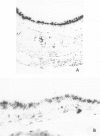Abstract
A rapid and sensitive method for the identification of human tissues xenotransplanted in nude mice was developed. An in situ hybridization technique made it possible to distinguish between cells of human origin and cells of murine origin in formalin-fixed paraffin sections. High-molecular-weight DNAs extracted from human or mouse tissues were sonicated, nick-translated with 32P-dCTP, and used as hybridization probes. Dot blot hybridization of 32P-labeled probes revealed clear species-specific signals. Formalin-fixed paraffin-embedded tissue samples from repopulated tracheal transplants, containing either human tracheal epithelial cells or human renal tubular cells, were used. Cells of human and murine origin were distinguishable by in situ hybridization with sonicated DNA probes. This method has several advantages; simple preparation of probes, high sensitivity, and applicability to formalin-fixed paraffin-embedded tissue sections. In situ hybridization with sonicated DNA probes should provide a powerful tool for verifying the human origin of xenotransplanted tissues in nude mice.
Full text
PDF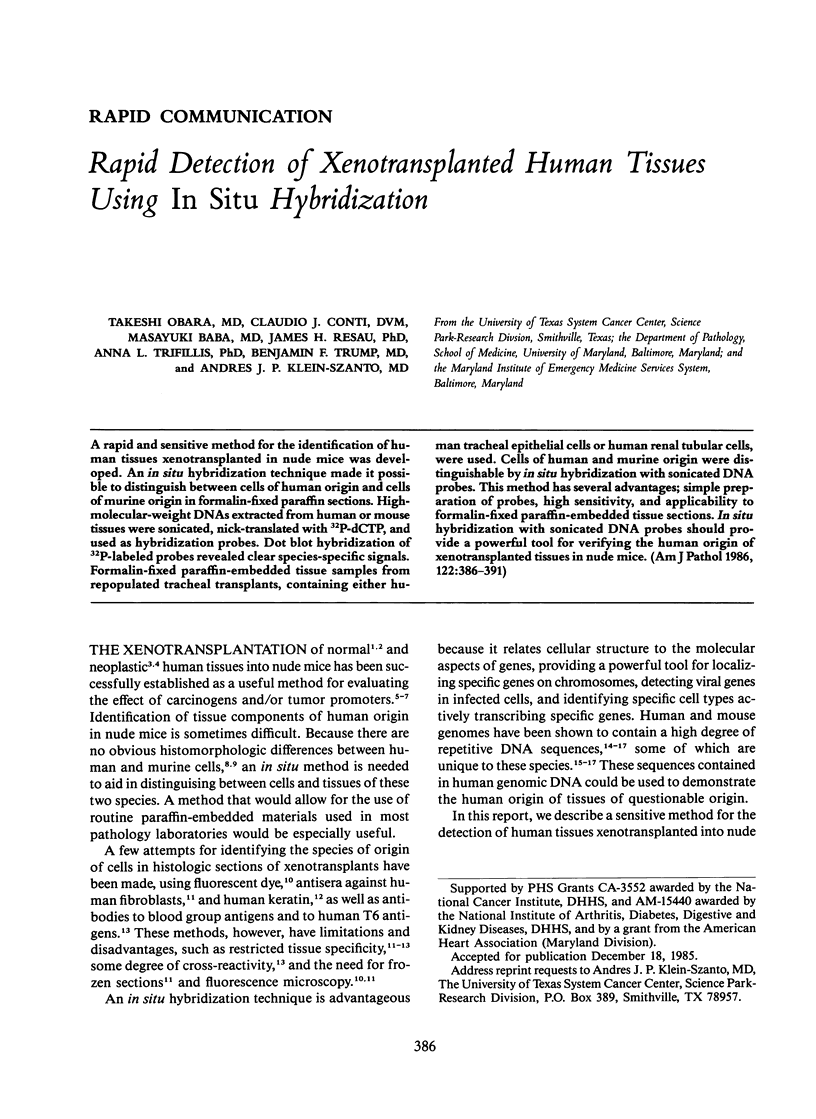
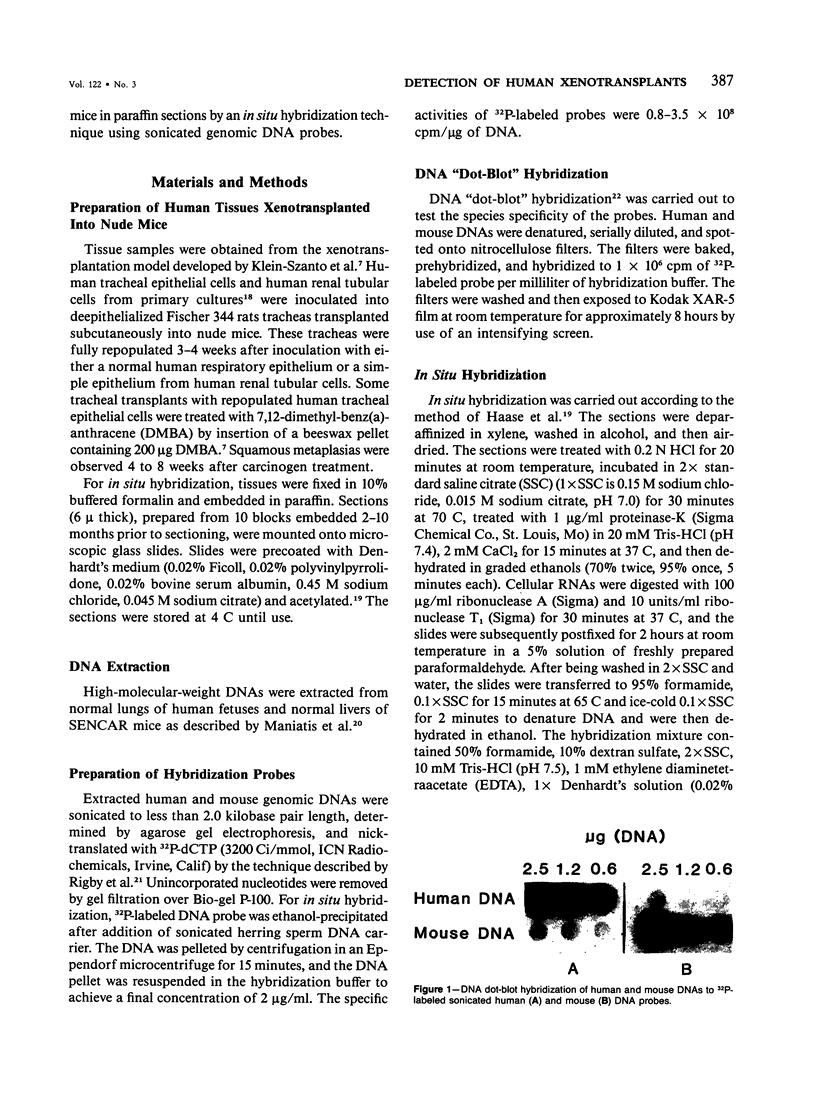
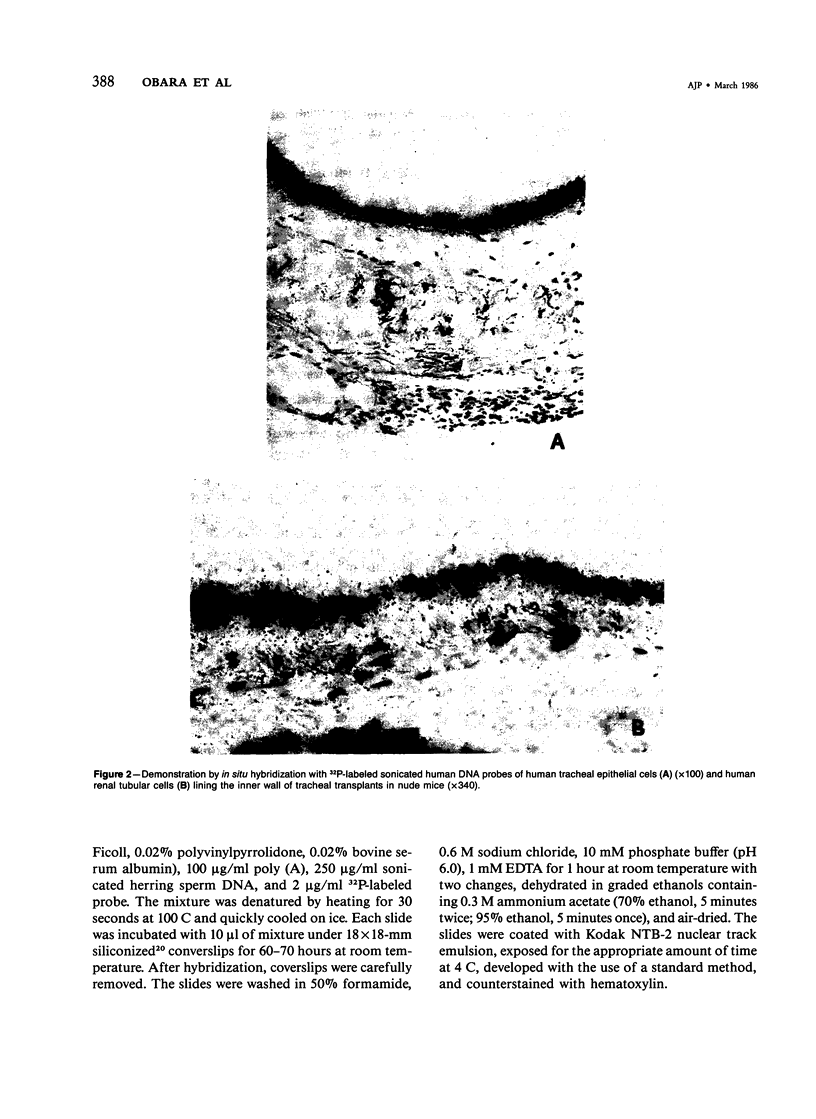
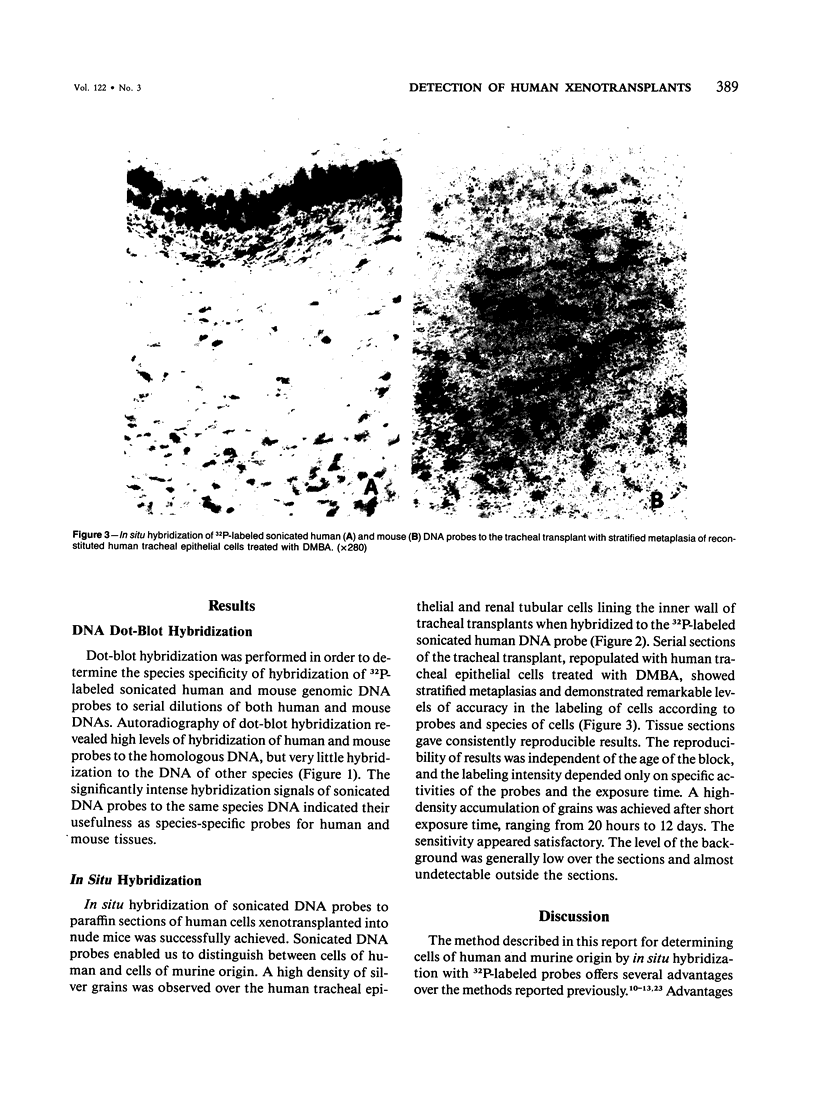
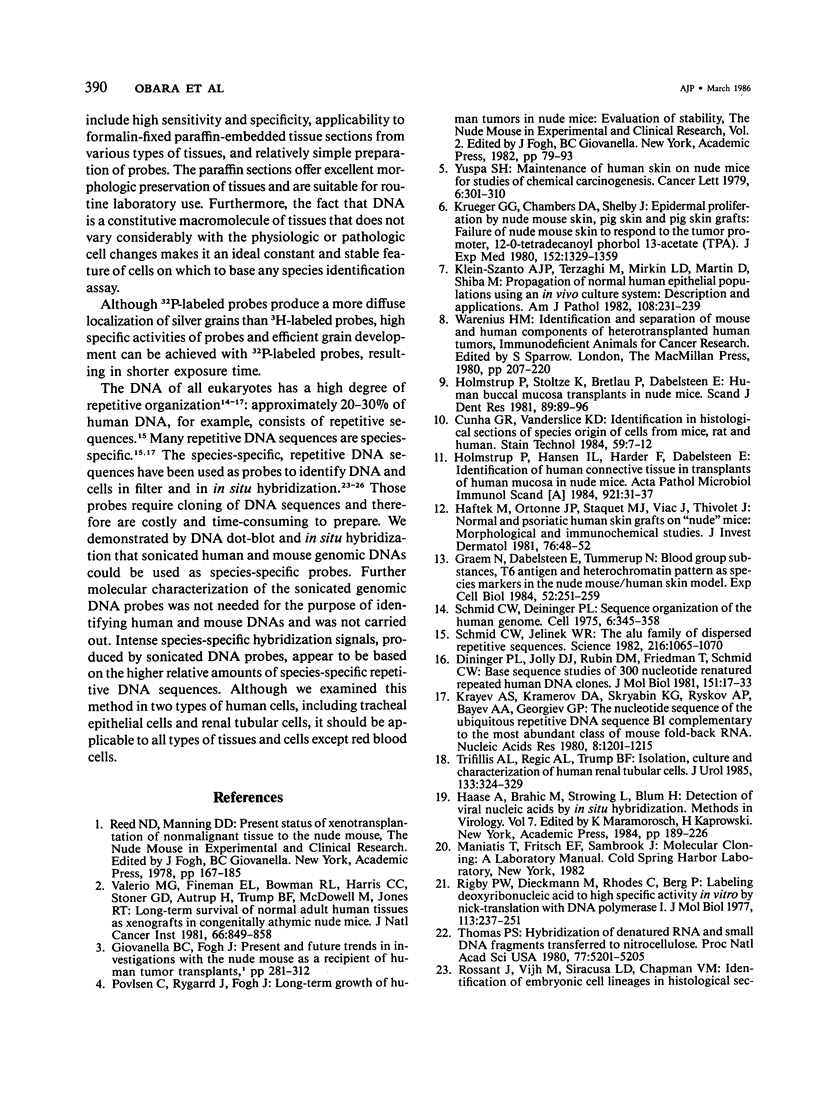

Images in this article
Selected References
These references are in PubMed. This may not be the complete list of references from this article.
- Cunha G. R., Vanderslice K. D. Identification in histological sections of species origin of cells from mouse, rat and human. Stain Technol. 1984 Jan;59(1):7–12. doi: 10.3109/10520298409113823. [DOI] [PubMed] [Google Scholar]
- Deininger P. L., Jolly D. J., Rubin C. M., Friedmann T., Schmid C. W. Base sequence studies of 300 nucleotide renatured repeated human DNA clones. J Mol Biol. 1981 Sep 5;151(1):17–33. doi: 10.1016/0022-2836(81)90219-9. [DOI] [PubMed] [Google Scholar]
- Graem N., Dabelsteen E., Tommerup N. Blood group substances, T6 antigen and heterochromatin pattern as species markers in the nude mouse/human skin model. Exp Cell Biol. 1984;52(4):251–259. doi: 10.1159/000163268. [DOI] [PubMed] [Google Scholar]
- Haftek M., Ortonne J. P., Staquet M. J., Viac J., Thivolet J. Normal and psoriatic human skin grafts on "nude" mice: morphological and immunochemical studies. J Invest Dermatol. 1981 Jan;76(1):48–52. doi: 10.1111/1523-1747.ep12524864. [DOI] [PubMed] [Google Scholar]
- Holmstrup P., Hansen I. L., Harder F., Dabelsteen E. Identification of human connective tissue in transplant of human oral mucosa in nude mice. Acta Pathol Microbiol Immunol Scand A. 1984 Jan;92(1):31–37. doi: 10.1111/j.1699-0463.1984.tb04374.x. [DOI] [PubMed] [Google Scholar]
- Holmstrup P., Stoltze K., Bretlau P., Dabelsteen E. Human buccal mucosa transplants in nude mice. Scand J Dent Res. 1981 Feb;89(1):89–96. doi: 10.1111/j.1600-0722.1981.tb01281.x. [DOI] [PubMed] [Google Scholar]
- Ishikawa F., Takaku F., Nagao M., Ochiai M., Hayashi K., Takayama S., Sugimura T. Activated oncogenes in a rat hepatocellular carcinoma induced by 2-amino-3-methylimidazo[4,5-f]quinoline. Jpn J Cancer Res. 1985 Jun;76(6):425–428. [PubMed] [Google Scholar]
- Klein-Szanto A. J., Terzaghi M., Mirkin L. D., Martin D., Shiba M. Propagation of normal human epithelial cell populations using an in vivo culture system. Description and applications. Am J Pathol. 1982 Aug;108(2):231–239. [PMC free article] [PubMed] [Google Scholar]
- Krayev A. S., Kramerov D. A., Skryabin K. G., Ryskov A. P., Bayev A. A., Georgiev G. P. The nucleotide sequence of the ubiquitous repetitive DNA sequence B1 complementary to the most abundant class of mouse fold-back RNA. Nucleic Acids Res. 1980 Mar 25;8(6):1201–1215. doi: 10.1093/nar/8.6.1201. [DOI] [PMC free article] [PubMed] [Google Scholar]
- Krueger G. G., Chambers D. A., Shelby J. Epidermal proliferation of nude mouse skin, pig skin, and pig skin grafts. Failure of nude mouse skin to respond to the tumor promoter 12-O-tetradecanoyl phorbol 13-acetate. J Exp Med. 1980 Nov 1;152(5):1329–1339. doi: 10.1084/jem.152.5.1329. [DOI] [PMC free article] [PubMed] [Google Scholar]
- Rigby P. W., Dieckmann M., Rhodes C., Berg P. Labeling deoxyribonucleic acid to high specific activity in vitro by nick translation with DNA polymerase I. J Mol Biol. 1977 Jun 15;113(1):237–251. doi: 10.1016/0022-2836(77)90052-3. [DOI] [PubMed] [Google Scholar]
- Rossant J., Vijh M., Siracusa L. D., Chapman V. M. Identification of embryonic cell lineages in histological sections of M. musculus in-equilibrium M. caroli chimaeras. J Embryol Exp Morphol. 1983 Feb;73:179–191. [PubMed] [Google Scholar]
- Schmid C. W., Deininger P. L. Sequence organization of the human genome. Cell. 1975 Nov;6(3):345–358. doi: 10.1016/0092-8674(75)90184-1. [DOI] [PubMed] [Google Scholar]
- Schmid C. W., Jelinek W. R. The Alu family of dispersed repetitive sequences. Science. 1982 Jun 4;216(4550):1065–1070. doi: 10.1126/science.6281889. [DOI] [PubMed] [Google Scholar]
- Shih C., Padhy L. C., Murray M., Weinberg R. A. Transforming genes of carcinomas and neuroblastomas introduced into mouse fibroblasts. Nature. 1981 Mar 19;290(5803):261–264. doi: 10.1038/290261a0. [DOI] [PubMed] [Google Scholar]
- Siracusa L. D., Chapman V. M., Bennett K. L., Hastie N. D., Pietras D. F., Rossant J. Use of repetitive DNA sequences to distinguish Mus musculus and Mus caroli cells by in situ hybridization. J Embryol Exp Morphol. 1983 Feb;73:163–178. [PubMed] [Google Scholar]
- Thomas P. S. Hybridization of denatured RNA and small DNA fragments transferred to nitrocellulose. Proc Natl Acad Sci U S A. 1980 Sep;77(9):5201–5205. doi: 10.1073/pnas.77.9.5201. [DOI] [PMC free article] [PubMed] [Google Scholar]
- Trifillis A. L., Regec A. L., Trump B. F. Isolation, culture and characterization of human renal tubular cells. J Urol. 1985 Feb;133(2):324–329. doi: 10.1016/s0022-5347(17)48932-4. [DOI] [PubMed] [Google Scholar]
- Valerio M. G., Fineman E. L., Bowman R. L., Harris C. C., Stoner G. D., Autrup H., Trump B. F., McDowell E. M., Jones R. T. Long-term survival of normal adult human tissues as xenografts in congenitally athymic nude mice. J Natl Cancer Inst. 1981 May;66(5):849–858. [PubMed] [Google Scholar]
- Yuspa S. H., Viguera C., Nims R. Maintenance of human skin on nude mice for studies of chemical carcinogenesis. Cancer Lett. 1979 Apr;6(4-5):301–310. doi: 10.1016/s0304-3835(79)80049-x. [DOI] [PubMed] [Google Scholar]




